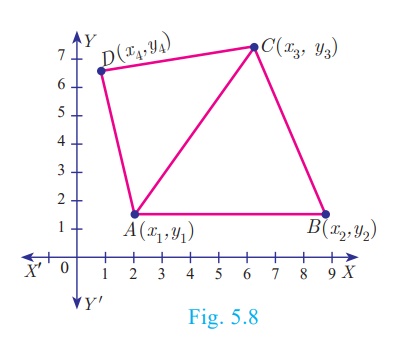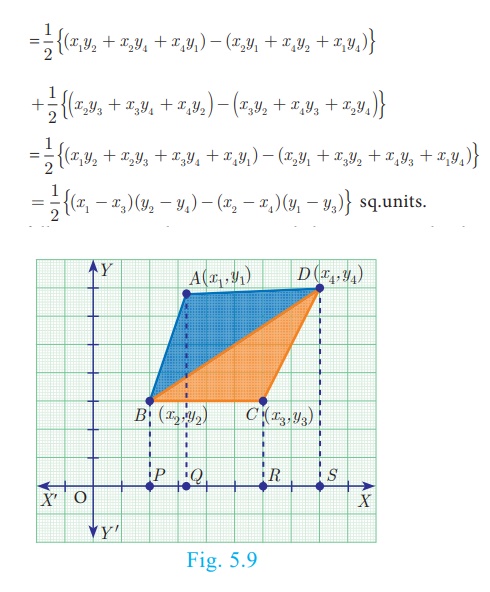Coordinate Geometry - Area of a Quadrilateral | 10th Mathematics : UNIT 5 : Coordinate Geometry
Chapter: 10th Mathematics : UNIT 5 : Coordinate Geometry
Area of a Quadrilateral
Area
of a Quadrilateral
If ABCD is a quadrilateral, then considering the diagonal AC, we
can split the quadrilateral ABCD into two triangles ABC and ACD.

Using area of triangle formula given its vertices, we can
calculate the areas of triangles ABC and ACD.
Now, Area of the quadrilateral ABCD = Area of triangle ABC + Area
of triangle ACD
We use this information to find area of a quadrilateral when its
vertices are given.
Let A(x1,y1), B(x2,y2), C(x3,y3) and D(x4,y4) be the vertices of a quadrilateral ABCD.
Now, Area of quadrilateral ABCD = Area of the ΔABD + Area of the ΔBCD
(Fig5.9)

Thinking Corner : How many triangles
exist, whose area is zero?
The following pictorial representation helps us to write the above
formula very easily.
Take the vertices A(x1,y1), B(x2,y2), C(x3,y3) and D(x4,y4) in
counter-clockwise direction and write them column-wise as that of the area of a
triangle.

Therefore, area of the quadrilateral ABCD
= 1/2 {(x 1y2 + x 2y3
+ x 3y4 + x 4y1
) − (x 2y1 + x3y2
+ x4y3 + x1y4
)} sq.units.
Note
·
To find the area of a quadrilateral, we divide it into
triangular regions, which have no common area and then add the area of these
regions.
·
The area of the quadrilateral is never negative. That is, we
always take the area of quadrilateral as positive.
Thinking Corner: If the area of a quadrilateral formed by the
points (a, a), (–a, a), (a, –a) and
(–a, –a), where a ≠ 0 is 64 square units, then identify
the type of the quadrilateral Find all possible values of a.
Related Topics